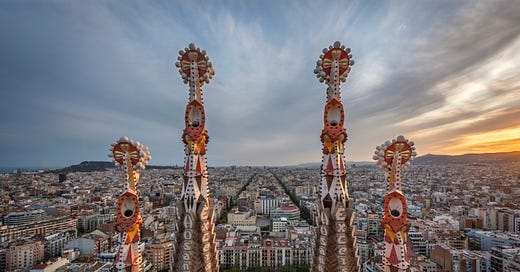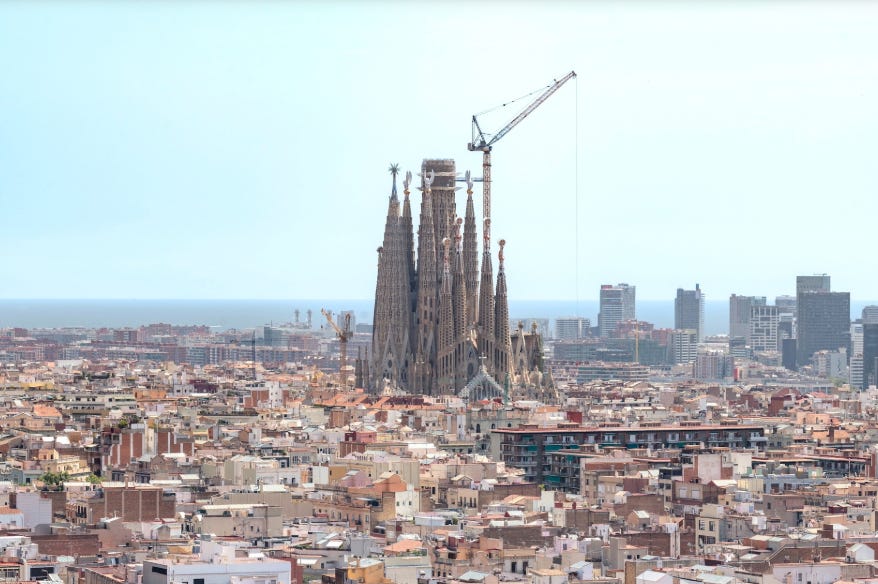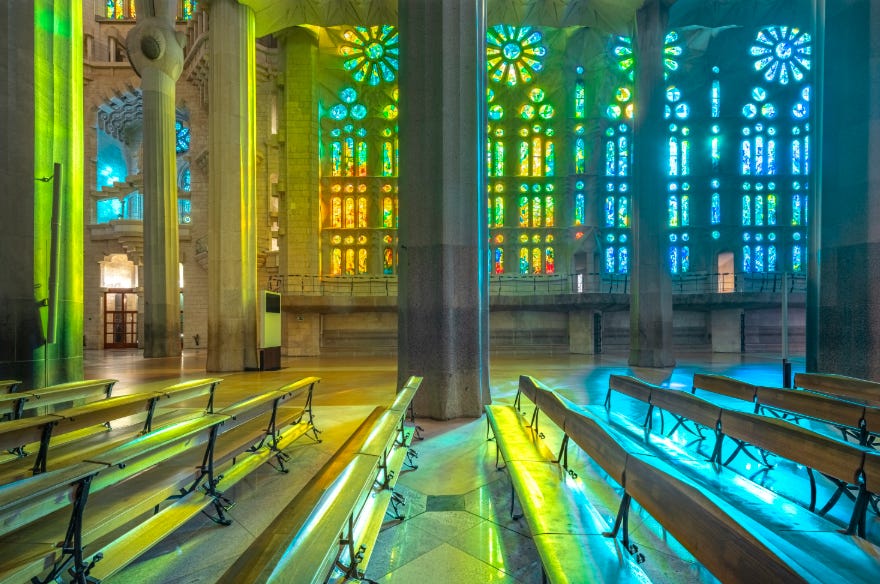
‘God’s architect’ - Will Antoni Gaudí be beatified?
How an architect's faith and basilica shaped his life
Pillar subscribers can listen to this article here: The Pillar TL;DR
The wild, extravagant spires of the basilica of Sagrada Familia, reaching up jauntily to the heavens, are as synonymous with the city of Barcelona as Lionel Messi, Las Ramblas, and the fierce battle for Catalan independence.
Take a walk through touristy parts of the city and you will see t-shirts, mugs, and plates emblazoned with images of its unique edifice. The city council has been forced to propose making a nearby square into an “anteroom” to ease tourist congestion.
Construction began in 1882 but it is still famously unfinished. In 2023, there were 4.7 million visitors to the basilica. But few realize that the man responsible for the design, Antoni Gaudí, is now a “Servant of God” being considered for sainthood. His cause for canonization is, according to the Archdiocese of Barcelona, in “the final process towards beatification.”
In the words of Pope Benedict XVI at the consecration of the basilica in 2010, this unique, visionary man was “nourished” by three books — “the book of nature, the books of Sacred Scripture, and the book of the liturgy” — so that he “brilliantly helped to build our human consciousness, anchored in the world yet open to God, enlightened and sanctified by Christ.”
And the very building that millions of people flock to see every year played a vital role in Gaudí’s transformation. One Lent he nearly starved to death because of the severity of his fasting. He eschewed the trappings of fame and wore cheap clothes, wanting to live like a simple worker.
When he was hit by a tram in June 1926, his humble clothing meant he was initially mistaken for a homeless person and taken to a pauper’s hospital.
Three days later he died, surrounded by loved ones, and his final words were “Amen. My God! My God!”
The entire city went into mourning. At his funeral, thousands attended, with a procession half a mile long.
A nun who, as a novice, took care of the housekeeping of Gaudí’s residence in Parc Güell, said: “He was a saint. Each year that passes I am more convinced of it. Now, in the year 1962, I believe that he deserves to be canonized.”
So who is the man behind Spain’s most famous building?
And which will be completed first — the basilica or his cause for sanctity?
Humble beginnings
Gaudí was born on June 25, 1852 and grew up in a rural environment between Reus and Riudoms in Catalonia. He was baptized the day after his birth and first received the Eucharist in 1862.
The Pillar talked with José Manuel Almuzara, an architect himself and formerly president of the Association for the Beatification of Antoni Gaudí, which was a private group that has now been dissolved, so that the Archdiocese of Barcelona can continue with the cause.
Almuzara said: “Gaudí’s religious beliefs were shaped by the education he received, particularly from his mother, the ‘Catechism of Christian Doctrine’ by Josep Domènech Costa i Borràs — which outlined seven fundamental points: prayers and doctrinal elements, apostles, doctrine of faith, doctrine of hope, doctrine of charity, doctrine of works, and rules for righteous living — and his schooling at the Piarist Schools of Reus.”
From a young age, Gaudí showed a fascination with nature, which is apparent in many of his major works.
According to his biographer, Isidre Puig Boada, Gaudí is reported to have said: “Due to my poor health, I often had to abstain from playing with my peers, which fostered my spirit of observation.”
Another time, Gaudí described his inspiration:
“Among flowerpots, surrounded by vineyards and olive trees, enlivened by the clucking of hens, the chirping of birds, and the buzzing of insects, gazing at the Prades mountains, I enjoyed the purest and most delightful images of Nature—Nature, which has always been my teacher.”
A crisis of faith?
In 1868, Gaudí moved to Barcelona and while working, completed high school and studied architecture. According to Almuzara, “the city was undergoing intense social, cultural, and political upheaval, with a secularist climate in which atheism, liberal enthusiasm, and utopian socialist ideals were spreading among university students.”
Gaudí was not immune to that environment, Almuzara explained, and he experienced a “crisis” of sorts. Those who knew Gaudí at this time said, “he became unconcerned with religion” and potentially also “a bit anticlerical and aggressive.”
But that was “overcome in late 1883 when he was commissioned to design and oversee the construction of the Expiatory Temple of the Sagrada Familia—an event that marked the beginning of his personal growth and increased spiritual commitment,” Almuzara said.

Another student of Gaudí — Fr. Xavier Vila, an expert on the architect who is an official guide at the Sagrada Família — told The Pillar that he was skeptical about claims of Gaudí’s youthful irreligiosity.
But the priest did say that Gaudí’s faith was “in process and in growth,” over the course of a lifetime.
Regardless, following his deep immersion in the Sagrada Familia project, Gaudí later said: “A man without religion is a maimed man.”
A life-changing job
The idea for the Sagrada Familia — the Expiatory Temple for the Holy Family — came from a group called the Association of the Devotees of St Joseph.
The association’s president, a bookseller and philanthropist named Josep Maria Bocabella, initially hired an architect named Francisco de Paula del Villar y Lozano to build it, and his plans were neo-Gothic.
The first stone was laid in 1882 on the feast of St Joseph.
But by 1883, del Villar resigned after disagreements with Bocabella.
Gaudí, an up-and-coming architect at the time and only 31 years old, was asked to take over.
His ideas for the basilica were different from del Villar’s: Gaudí’s vision was inspired by nature, infused with Christian symbolism, and with his trademark organic and curvilinear forms.
The project was, and still is, entirely funded by private backers. Gaudi won their trust with his charm, good reputation, and creativity. He took full control as soon as he was appointed to the project, and he started bringing his spectacular vision to life.
From the start, Gaudí appreciated the sacred aspect of the basilica.
“The temple is the house of God and the house of prayer,” he told collaborators.
As the project progressed, so did his faith. Some reports say that as a young man, Gaudí had his own tailor and enjoyed restaurants, opera and the theatre.
But during the basilica’s construction, the architect began to reject the lavish lifestyle he had been living, turning down many lucrative contracts from New York and Paris.
He became an ascetic. He stopped eating meat; for lunch he would eat a few lettuce leaves dipped in milk. He built schools for the children of workers and parishioners. He dressed as simply as he could.
The change happened over years. But Almuzara told The Pillar that in 1894 “Gaudí underwent an important process of conversion.”
That year, inspired by his years working on the basilica, he undertook a complete Lenten fast that was to last 40 days.
Because Gaudí was so well known, the fast was followed every day by the Barcelona press.
Gaudí became severely ill — he might have died from the fast, if not for the intervention of Bishop Josep Torras i Bages.
The bishop instructed “God’s architect” that God had given him one mission: to construct the Sagrada Familia.
According to Almuzara, the fast “as preparation to begin the Nativity Façade, led him to dedicate himself to building” the basilica — it became more and more his primary work until 1914, when he gave up all other projects, to work exclusively on the church.
Fr. Xavier concurred that after the fast “faith and life in him became one, fused, and reached its deepest and most artistic and vital expression.”
He said “the Sagrada Familia shaped his faith” because it was inspired by “creation, the Word of God, and the liturgy.”
It was Gaudí’s belief that architecture and beauty could be used as a means to introduce people to God, but in the process he too grew closer to Him.
Thus, his biographers say, as Gaudí molded the stones, his soul was molded by his work. His life became more ascetic: prayer, fasting, daily Mass, and regular confession.
Fr. Xavier commented that “his love for Scripture, liturgy, and nature as divine creation shaped the Sagrada Familia and also shaped Gaudí’s soul, creating in him, in parallel, a majestic interior sanctuary.”
His death and legacy
Gaudí dedicated more than four decades of his life to the Sagrada Familia. By the time of his death, June 10, 1926, he had moved to live in a workshop in the basilica.
In his lifetime, he only saw the completion of the Nativity Façade, the east-facing facade that celebrates the birth of Jesus. He also only saw one spire constructed, but the design has 18: 12 for the apostles, 4 for the evangelists, one for the Virgin Mary, and one for Christ.
Famously, Gaudí was in no rush to finish, saying of Christ: “My client can wait.”
Following his death, architects have been employed to finish his designs, and many have travelled far to see his work.
Japanese architect Kenji Imai visited Barcelona to study Gaudí and converted to Catholicism. A Japanese sculptor, Etusoro Sotoo, moved to Barcelona to work on the Sagrada Familia, and also converted from Shintoism to Catholicism.
In September 1997, Jun Young Joo, the director of the Chamber of Commerce and Industry in the Korean city of Pusan visited Barcelona to arrange an exhibition of Gaudí’s work in Pusan. Then a Buddhist, Joo was so moved by the spirituality in Gaudí’s work that on returning to Korea he took Catholic instruction. On Christmas Eve he was baptized.
Gaudí’s cause for canonization was officially opened by the Vatican in 2003, and is now is in its “final process,” with two alleged miracles from Gaudí’s intercession needing the Vatican’s recognition. Almuzara explained that for Gaudí to be declared Venerable all that is now needed is Pope Francis’ approval.
Meanwhile, those spires that define Barcelona’s skyline edge towards completion: by 2024, 12 of 18 were finished.
Father Xavier said Gaudí’s disciples believed “his faith grew as the towers of the Sagrada Familia grew in height.” It seems, too, that the faith of visitors grows — Catholics and non-Catholics alike — in the shadow of his masterpiece.
Gaudí himself prophesied that people would come from all over to contemplate the wonders of the Sagrada Familia. What he didn’t say was that they would be contemplating not only the work of a creative genius and visionary, but perhaps that of a future saint.
















Wow, this is so cool. I wasn’t aware that his cause had been opened! Thanks for reporting on it!
This is really cool. I never knew of Gaudi's personal life/background and religious affections.
Imagine being so good at your job as an Spanish architect that you start converting Japanese people.
Serving the poor is great and all, but I really really love a good "out of left field" hagiography. That's a big reason why Saint Carlo Acutis immediately garnered such popularity: a gamer with a N64 and a copy of Goldeneye who made a website (among other things, of course). More saints with stories like these!
I imagine a good quip would be: "Gaudi got to heaven because he built a really good building. You too can sanctify your own job and make it there as well."